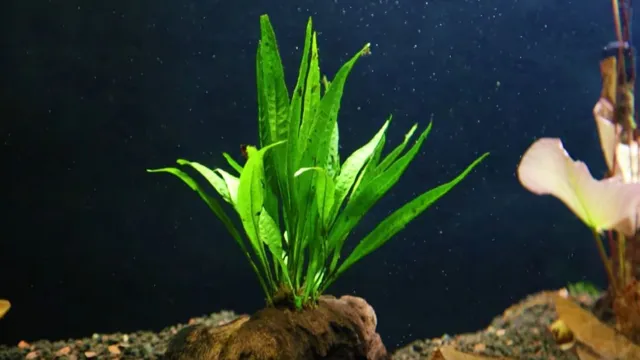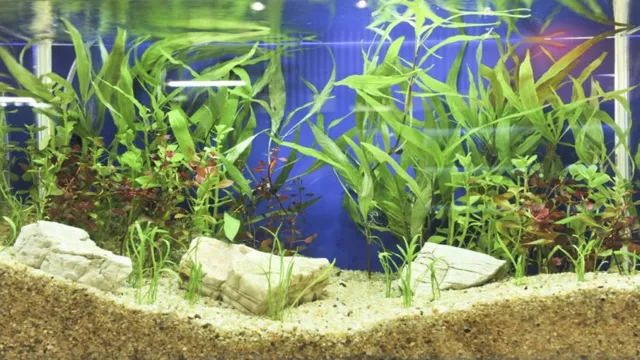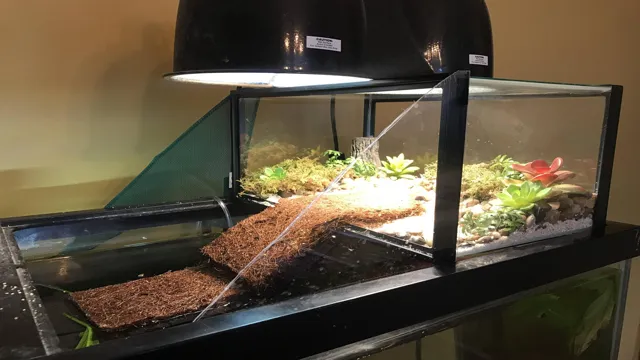Do you want to keep your aquarium looking crisp and clean? One important aspect of aquarium maintenance is the sand bed. If not properly cared for, the sand can become murky and filled with waste, which is not only unsightly but also harmful to your aquatic pets. That’s why maintaining aquarium sand is crucial for the overall health and appearance of your aquarium.
First and foremost, regular vacuuming is essential for keeping the sand bed clean. This can be done manually using a siphon or with the help of a specialized vacuum. Removing accumulated waste and debris will prevent the sand bed from becoming a breeding ground for harmful bacteria.
Another trick to maintaining clean and healthy aquarium sand is to stir it regularly. This will help prevent excess debris from settling on the bottom, which could ultimately cause toxic gas buildup. Stirring the sand is easy and can be done with the help of a gentle tool like a plastic spoon or a chopstick.
Additionally, it’s important to choose the right type of sand for your aquarium. Play sand or beach sand should be avoided as it often contains impurities and debris that can harm your aquatic pets. Instead, invest in aquarium sand that is specifically designed for the purpose, and consider choosing a finer grade that is easier to clean and won’t cause damage to your aquatic equipment.
By following these simple tips and tricks, you can maintain a clean and healthy sand bed in your aquarium, providing a safe and beautiful home for your aquatic pets.
Introduction
Maintaining aquarium sand is essential for the health and well-being of your aquatic pets. It’s crucial to know how to keep the sand clean to avoid littering of debris and build-up of organic waste that can harm the fish. One way of maintaining the sand is by using a siphon to get rid of debris and excess food that sinks to the bottom.
Another way is by introducing clean-up crew animals, such as snails and shrimp, that help reduce waste in the aquarium. Additionally, it’s vital to keep an eye on the sand’s pH, as it may drop due to bacterial activity, leading to a build-up of toxic gases. Testing the water frequently and adding additives may help regulate the pH.
In conclusion, maintaining aquarium sand requires a consistent effort in ensuring the water remains clean, tested, and free from any harmful substances that can impact the fish and plants.
– Importance of maintaining aquarium sand
Maintaining aquarium sand is an essential yet often overlooked aspect of fishkeeping. It’s common for novice aquarium enthusiasts to think that sand only serves as a decorative element and not a functional one. However, sand plays a crucial role in creating a healthy environment for aquatic animals.
It provides a natural habitat for beneficial bacteria that break down waste and keep the water clean, helping to maintain optimal water conditions. A dirty substrate can quickly accumulate harmful debris, causing various problems in the aquarium. It’s why it’s essential to keep sand clean by vacuuming it regularly and removing any uneaten food or plant matter that may have settled on it.
By keeping the aquarium sand clean and well-maintained, you’ll create a healthy and vibrant underwater ecosystem for your fish to thrive in.

– Factors affecting sand maintenance
Sand maintenance is a critical aspect of ensuring the longevity and safety of outdoor surfaces. Factors affecting sand maintenance can range from weather patterns, usage, and the quality of sand itself. In regions with high rainfall, waterlogged sand can lead to deterioration, which amplifies the risk of injuries and accidents.
On the other hand, sand surfaces in arid regions require frequent replenishing due to erosion caused by wind. Heavy usage on sand surfaces such as playgrounds, sports fields, and beaches can also affect the quality of sand, leading to compaction and decreased impact absorption. The quality of sand used also plays a crucial role, with inferior quality sands being more susceptible to erosion and dust.
To ensure the best sand quality, it is essential to source sand from trusted and certified suppliers. Overall, proper sand maintenance requires regular upkeep and monitoring of these crucial factors, ensuring safe, effective, and long-lasting sand surfaces.
– Materials needed for sand maintenance
Sand maintenance is crucial to maintaining the long-term functionality and aesthetic appeal of various outdoor spaces such as playgrounds, landscaping, and sports fields, among others. There are specific materials needed to achieve proper sand maintenance activities that ensure the cleanliness, safety, and sustainability of the sand surfaces. Some of these materials include sand rakes, sand sifters, sand cleaners, and power brooms. (See Also: How to Grow Daphnia for the Aquarium: Tips and Tricks for Keeping Your Fish Healthy)
Sand rakes are ideal for removing debris or stones from the sand surface, while sand sifters enable the even distribution of sand. Sand cleaners use mechanically operated brushes and sieves to remove unwanted materials from the sand surface, and power brooms help in leveling the surface. All these materials work together to ensure a clean, safe, and aesthetically appealing sand surface.
How to Maintain Aquarium Sand
Maintaining aquarium sand is a necessary task that ensures the health and vitality of your aquatic pets. The first step in maintaining aquarium sand is to regularly clean and vacuum the sand bed. Accumulated debris and waste can quickly turn into a harmful environment for your fish and other creatures, so it’s vital to remove it from the bottom of the tank.
Additionally, it’s essential to keep the sand pH balanced and oxygenated by aerating the water with a quality pump and filter. Another aspect to consider when taking care of aquarium sand is to monitor the levels of nitrates, nitrites, and ammonia in the water and make adjustments when necessary. Ultimately, keeping aquarium sand and the surrounding environment clean and healthy is vital for the longevity of your aquatic pets and the overall aesthetic of your tank.
By following these tips on how to maintain aquarium sand, you can ensure a happy and healthy underwater habitat.
– Step-by-step guide to cleaning aquarium sand
If you’re looking to maintain a healthy aquarium, keeping the sand clean is crucial. To clean your aquarium sand, start by using a siphon to remove any debris and waste from the surface. Then, use a gravel cleaner or a fine-mesh net to remove any tiny particles that may have settled on the sand.
It’s important to avoid using any toxic chemicals or detergents that can harm your fish or alter the water chemistry. Instead, you can use a natural cleaning agent like vinegar or lemon juice to remove any stubborn stains or buildup. Simply mix a small amount of vinegar or lemon juice with water, apply it to the affected areas, and rinse thoroughly.
With these simple steps, you can keep your aquarium sand clean and healthy for your fish to thrive in.
– How to prevent algae growth on sand
Maintaining aquarium sand can be a tough job, and one of the biggest challenges is preventing algae growth. To keep your sand looking pristine, there are a few things you can do. Firstly, invest in a powerful filtration system to keep the water clean and free from debris.
Secondly, ensure adequate lighting and avoid leaving the aquarium under direct sunlight, which can lead to excessive algae growth. Thirdly, incorporate live plants into your aquarium, which absorbs excess nutrients that promote algae growth. Finally, consider using algae-eating fish or snails in your aquarium, which can help to keep algae growth under control.
By following these steps, you can keep your aquarium sand looking healthy and algae-free for a long time.
– Tips for maintaining a healthy sand bed
Maintaining a healthy sand bed in your aquarium is critical for the overall health and longevity of your aquatic environment. One of the essential things to keep in mind is to ensure that the sand is not disturbed too much during cleaning or maintenance. When cleaning, make sure to use a siphon or vacuum that gently removes debris without stirring up the sand too much, as this can release harmful compounds such as hydrogen sulfide.
Another crucial factor is to keep the sand bed well-oxygenated and prevent dead spots by regularly adding live sand or stirring the sand bed. It’s also important to watch out for any signs of excess nutrients or waste buildup, such as cloudy water or an unpleasant odor. By maintaining a healthy sand bed, your aquarium will thrive, and your aquatic animals will be happier and healthier.
Common Mistakes to Avoid
Maintaining aquarium sand might seem like a straightforward task, but there are a few common mistakes to avoid. One mistake is over-cleaning the sand. While it’s important to remove any debris and waste, over-cleaning can also remove essential bacteria that help to keep the aquarium healthy.
Another mistake is adding too much sand to the aquarium. This can create a buildup of harmful gases that could harm fish and other aquatic life. It’s also important to choose the right type of sand for your aquarium, as some types can alter the pH levels and overall chemistry of the water. (See Also: How to Make a Forest Aquarium: A Step-by-Step Guide for Nature Lovers)
By avoiding these common mistakes and properly maintaining the sand in your aquarium, you can create a healthy and thriving aquatic environment for your fish and other aquatic life.
– Over-cleaning the sand
When it comes to maintaining a sand-bottomed aquarium, over-cleaning the sand is a common mistake that many beginners make. It’s understandable, as no one wants a dirty aquarium with odors and murky water. However, excessive cleaning can remove beneficial bacteria and microorganisms that are essential for a healthy fish tank.
In addition, the sand can be easily disturbed and clouded, making your aquarium look worse than before. The key is to clean the sand only when needed, and in moderation. You can use a siphon to vacuum the debris and excess food that has settled on the surface of the sand, but avoid disturbing the deeper layers too much.
Remember that a little bit of dirt is good for diversity and the natural balance of your aquarium ecosystem. By taking the time to learn the ideal cleaning frequency and method, you can avoid this common mistake and ensure a thriving, healthy aquarium for your fish and plants.
– Under-cleaning the sand
When it comes to maintaining a sand-based aquarium, under-cleaning the sand is a common mistake that many beginners make. Some aquarists believe that over-cleaning the sand can harm the beneficial bacteria that live in the substrate, but neglecting to clean it at all can lead to a buildup of waste and harmful toxins. It’s important to strike a balance and clean the sand regularly using a siphon or gravel vacuum to remove any debris and uneaten food.
Remember to also stir the sand to prevent any pockets of anaerobic bacteria from forming. By avoiding the mistake of under-cleaning the sand, you’ll help keep your aquarium clean and healthy for your aquatic pets to thrive in.
– Using harmful chemicals
When it comes to cleaning, it can be tempting to reach for harsh chemicals to get the job done quickly. However, this can lead to serious consequences for both your health and the environment. One common mistake to avoid is using harmful chemicals that contain toxic substances such as bleach, ammonia, and phthalates.
These chemicals can cause respiratory irritation, allergic reactions, and even contribute to indoor air pollution. Furthermore, they can contaminate water sources and harm aquatic life. Instead of relying on these harmful cleaners, opt for natural alternatives such as vinegar, baking soda, and essential oils.
By making these simple swaps, you can help protect yourself and the planet while still maintaining a clean and healthy home.
Conclusion
In conclusion, maintaining aquarium sand is a delicate process that requires attention and care. Just like any relationship, you need to make sure your sand is happy and healthy by regularly removing debris and keeping the water clean. It’s important to remember that while it may seem like a tedious task, a little bit of effort can go a long way in ensuring the longevity of your aquatic environment.
So don’t let your sand become yesterday’s news – keep it fresh and exciting, and watch as it becomes the star of your underwater world.”
– Benefits of properly maintaining aquarium sand
When it comes to maintaining aquarium sand, there are certain mistakes that you need to avoid. Firstly, never use tap water to clean the sand as it can contain chlorine or other harmful chemicals that can harm the fish. Instead, use aquarium sand cleaner and follow the instructions provided by the manufacturer.
Secondly, don’t over-clean the sand as it can remove beneficial bacteria that are crucial for the survival of fish, leading to fish stress and illness. It’s recommended to clean only 20-30% of the sand during each water change. Thirdly, avoid using harsh chemicals like bleach to clean the sand as it can be toxic to the fish. (See Also: What Size Pump for My Aquarium: A Complete Guide to Choosing the Right Aquarium Pump)
Always use safe and fish-friendly cleaning products to maintain your aquarium sand. Lastly, don’t forget to maintain the sand bed along with other aquarium maintenance tasks, as it plays a crucial role in the overall health of your aquarium. By avoiding such mistakes, you can ensure that your aquarium sand stays healthy and vibrant, providing a beautiful home for your fish.
– Final thoughts and recommendations
When it comes to creating content, there are some common mistakes you should avoid to ensure your message is effectively communicated to your audience. One of the biggest mistakes is not understanding your target audience and tailoring your content to their needs and interests. It’s important to research your audience and use language they can relate to and understand.
Additionally, many content creators make the mistake of focusing too much on quantity over quality. While it’s good to consistently produce content, it’s better to publish fewer pieces that are well-researched, engaging, and valuable to your audience. Another mistake to avoid is not optimizing your content for SEO.
Incorporating relevant keywords, optimizing images, and having a clear structure can help your content rank higher in search engine results. By avoiding these common mistakes and focusing on creating high-quality content that resonates with your audience and is optimized for search engines, you can ensure your content is seen, shared, and drives results.
FAQs
How often should I clean my aquarium sand?
It is recommended to clean your aquarium sand once every two weeks to remove any accumulated debris or waste.
Can I reuse sand from an old aquarium?
Yes, you can reuse sand from an old aquarium by thoroughly cleaning and rinsing it before adding it to a new tank.
Should I use a sand substrate in a planted aquarium?
Yes, a sand substrate can be a great choice for a planted aquarium as it provides a stable and nutrient-rich base for plants to grow.
How much sand do I need for my aquarium?
The amount of sand you need for your aquarium depends on the size and depth of your tank. A general rule of thumb is to have around 1-2 pounds of sand per gallon of water.
What type of sand is best for aquariums?
The best type of sand for aquariums is typically fine-grained sand with a consistency that is easy to clean and does not contain any harmful chemicals or dyes.
Can I mix different types of sand in my aquarium?
Yes, you can mix different types of sand in your aquarium as long as they are compatible and do not contain any sharp or jagged pieces that could harm fish or plants.
How do I prevent sand from getting sucked into my aquarium filter?
To prevent sand from getting sucked into your aquarium filter, you can use a pre-filter or sponge filter designed specifically for this purpose. It is also important to adjust the water flow rate to prevent sand from being stirred up too much.







